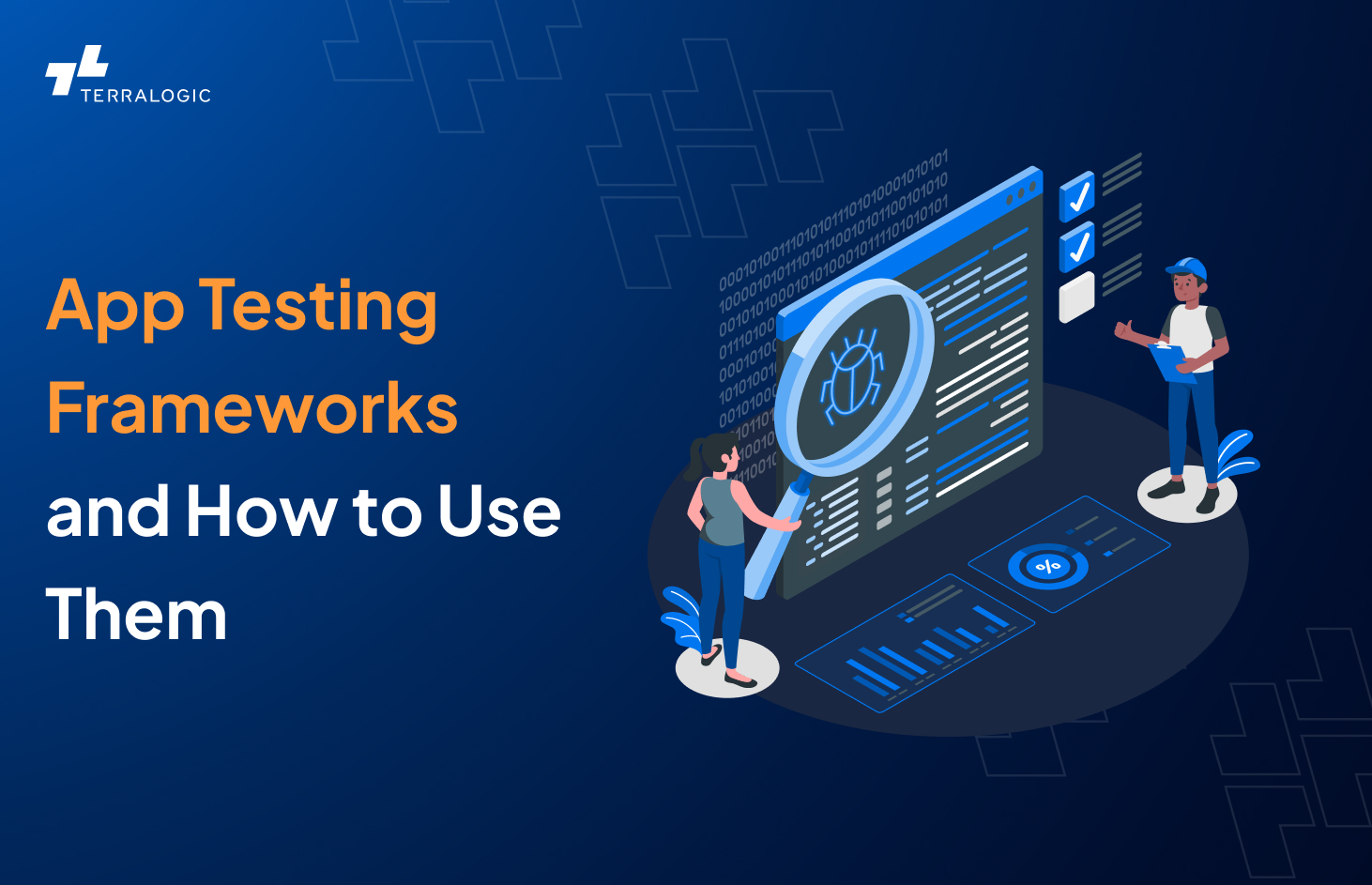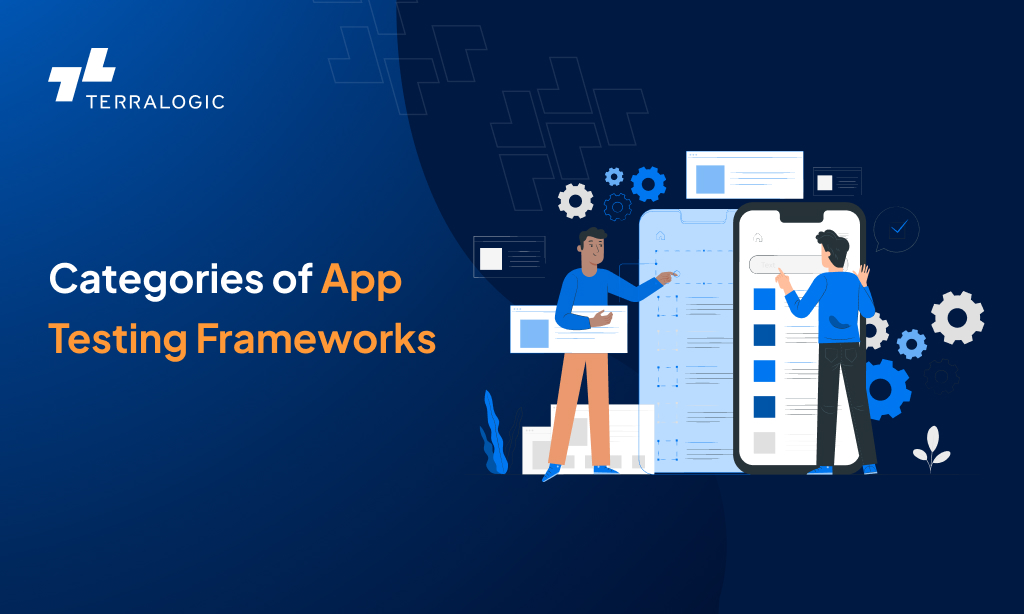App Testing Frameworks and How to Use Them
November 7, 2024

The environment of mobile and web applications has changed quickly, and as competition grows, companies and developers need to produce high-caliber apps that function at their best in various scenarios. App testing frameworks come in quite handy in this situation. They enable developers and QA teams to automate, streamline, and scale testing procedures to guarantee that an application satisfies user expectations, operates as intended, and maintains stability across platforms.
Why App Testing is Critical
An essential part of the development lifecycle is app testing. Any application that doesn’t work as intended will fail, no matter how talented a development team is or how innovative your product idea is. It is necessary to test your app. Testing guarantees:
- Bug detection and elimination are critical for maintaining app quality and performance. Identifying and fixing bugs early in the development stage minimizes the risk of costly issues later. This can be done by automated testing. Automated testing frameworks help streamline this process, ensuring stable, error-free code and a smoother user experience across platforms.
- Improved security includes identifying susceptibility and verifying applications are protected against threats like data breaches and unauthorized access. Security testing frameworks like OWASP ZAP and Burp Suite help developers find issues early, boosting the app’s defenses and safeguarding user data from potential cyberattacks.
- Enhanced performance: A well-tested app performs consistently, whether a single user or millions are using it.
- Cross-platform compatibility: Testing frameworks ensure cross-platform compatibility by enabling automated testing across multiple devices, browsers, and operating systems. This corroborates the app functions consistently and reliably for all users, in any situation. Frameworks like Selenium, Appium, and Xamarin facilitate this by supporting diverse platforms and reducing manual testing efforts.
With a solid testing strategy, you’re set to deliver a smooth, fast, and reliable app to your users—boosting your brand, revenue, and credibility.
Categories of App Testing Frameworks
There is no one-size-fits-all approach to app testing. Depending on the part of the application you’re evaluating, different types of tests are needed. Below is a summary of the primary categories:

1. Unit Testing Frameworks
Objective: Unit testing frameworks make sure that each unit operates as intended when used alone by focusing on confirming the functionality of distinct parts or features inside an application. The main goal is to test tiny, manageable code portions to identify flaws early in the development process. This will speed up the development cycle, enhance code quality, and make debugging easier. Frameworks like JUnit, NUnit, and PyTest allow developers to continuously assess changes and make sure that upgrades don’t disrupt existing functionality. Additionally, unit testing uplifts improved modularity and code organization, which eventually results in cleaner and easier-to-maintain codebases.
Common Frameworks: JUnit (for Java), NUnit (for .NET), and PyTest (for Python).
2. UI/Functional Testing Frameworks
Objective: UI/Functional testing frameworks aim to validate the application’s user interface and overall functionality from the end user’s perspective. Their main goal is to confirm that all user interactions—like button clicks, form submissions, and navigation flows—function properly across different devices and platforms. These frameworks simulate real-world user actions to detect potential issues in layout, functionality, and performance. By automating repetitive tests, frameworks like Selenium, Appium, Espresso, and XCUITest help identify and fix errors efficiently, ensuring a seamless user experience. They also support cross-browser and cross-platform testing, ensuring consistent behavior across different environments.
Common Frameworks: Selenium, Appium (for mobile), Espresso (for Android), XCUITest (for iOS).
3. Integration Testing Frameworks
Objective: Objective: Verifying that several modules or components of an application function together as intended is the main goal of integration testing frameworks. They test integration points to ensure seamless communication across various system components, including databases, APIs, and third-party services. Integration tests assist in locating problems that isolated unit tests could miss, such as those about data flow, component interactions, and overall system behavior. These are automated using frameworks such as TestNG, Mocha, and RSpec, which allow for the early identification of incompatibilities or failures and guarantee that the system works without malfunctioning when individual components are combined.
Common Frameworks: TestNG (Java), Mocha (JavaScript), or RSpec (Ruby).
4. Load and Performance Testing Frameworks
Objective: The purpose of load and performance testing is to evaluate an application’s stability and behavior in a variety of scenarios, including heavy usage or high traffic. Making sure the application can manage a given load, uphold performance standards, and scale efficiently without crashing or slowing down is the major goal. These tests track important metrics, including response time, throughput, and resource usage, to look for bottlenecks and performance problems. By simulating real-world user scenarios and testing system limits, tools like JMeter, LoadRunner, and Gatling assist developers in optimizing the application for improved performance, dependability, and scalability under varying demand levels.
Common Frameworks: JMeter, LoadRunner, and Gatling.
5. Security Testing Frameworks
Objective: Security testing frameworks aim to identify vulnerabilities within an application to protect it from potential threats and unauthorized access. The primary objective is to ensure data confidentiality, integrity, and availability by simulating attacks and testing security measures. The objectives of frameworks are to detect issues such as SQL injections, cross-site scripting (XSS), and data leaks, which could compromise user information or system functionality. Tools like OWASP ZAP, Burp Suite, and Acunetix automate vulnerability scans and penetration tests, allowing developers to address security risks proactively. Using these frameworks, organizations can safeguard their applications, meet compliance standards, and maintain user trust.
Common Frameworks: OWASP ZAP, Burp Suite.
Also Know About our Application Development Services & App Modernization
Popular App Testing Frameworks
Here are some of the most widely used testing frameworks across different categories:
1. JUnit
JUnit is one of the most popular unit-testing frameworks for Java applications. It provides annotations to identify test methods and assertions to test expected results.
Key Features:
- Simple integration with CI/CD pipelines.
- Annotations for better test case management.
2. Selenium
Selenium is a widely used testing framework for automating browser-based applications. It supports multiple programming languages, including Java, Python, and JavaScript.
Key Features:
- Cross-browser and cross-platform support.
- Powerful browser automation with WebDriver API.
3. Appium
Appium is an open-source mobile application testing framework, ideal for automating both Android and iOS applications. It allows cross-platform testing with one API and supports multiple languages.
Key Features:
- Write tests in multiple programming languages.
- Test native, hybrid, and mobile web apps.
4. Espresso
Espresso is a native testing framework for Android apps that allows developers to write concise and reliable tests. It grants the ability to simulate user interactions and assert the UI’s behavior, ensuring that the app functions as intended.
Key Features:
- Automatic synchronization of test actions.
- Powerful APIs for UI testing.
XCUITest
XCUITest is Apple’s UI testing framework for iOS applications, seamlessly integrated into Xcode.
Key Features:
- Fast test execution.
- Deep integration with Xcode’s debugging tools.
How to Select the Right Framework
Key Factors in Evaluating App Testing Frameworks
1. Project Requirements Define the app’s functional and technical requirements. For example, a financial app requires extensive security testing, while a social media app needs a strong emphasis on UI and performance testing. Each type of testing has dedicated frameworks, so pinpointing specific needs can narrow down options and a focused approach.
- Unit Testing: Identify frameworks like JUnit, NUnit, and PyTest for validating code functions.
- Functional/UI Testing: Frameworks like Selenium, Appium, and Espresso focus on simulating user actions.
- Integration Testing: TestNG, Mocha, and RSpec help in verifying interconnected systems.
- Performance Testing: JMeter and LoadRunner measure load handling capabilities.
- Security Testing: OWASP ZAP and Burp Suite identify security vulnerabilities.
2. Technology Stack Compatibility A compatible framework seamlessly integrates with your project’s technology stack, improving efficiency and minimizing setup complexities. Evaluate:
- Language and Platform Support: Frameworks like JUnit and NUnit are specific to Java and .NET, respectively, while others like Selenium and Appium support multiple languages.
- Operating System: Choose frameworks compatible with OS requirements; for example, XCUITest is specific to iOS, whereas Appium works across iOS, Android, and mobile web.
- Development Tools Integration: Ensure compatibility with IDEs, build tools (e.g., Maven, Gradle), and CI/CD tools like Jenkins or GitLab.
3. Team Expertise and Learning Curve The team’s familiarity with a framework directly impacts productivity. Opt for frameworks that align with team skills or have extensive documentation, training resources, and community support. For instance:
- Skill Familiarity: For Java-based teams, JUnit or TestNG is often preferable due to native language support.
- Community and Documentation: Popular frameworks like Selenium have active communities and extensive documentation, easing onboarding and troubleshooting.
4. Automation Capabilities Automation reduces manual testing and expedites feedback. Key features to assess include:
- Scripting Support: Ensure the framework supports automated scripting in languages compatible with your stack (e.g., Selenium supports Java, Python, and C#).
- Test Suite Management: Look for frameworks that facilitate comprehensive test suite organization, allowing easy scheduling and version control.
- Integration with CI/CD Pipelines: Automation frameworks should easily integrate with CI/CD tools to support continuous testing (e.g., Jenkins integration for Selenium tests).
5. Cross-Platform Compatibility If your app targets multiple platforms (e.g., web, Android, iOS), a cross-platform framework streamlines testing across all intended environments.
- Device and OS Versatility: Frameworks like Appium allow tests on both Android and iOS, reducing the need for multiple testing tools.
- Browser Compatibility: For web apps, Selenium provides robust cross-browser support, testing across Chrome, Firefox, Safari, and others.
6. Scalability The chosen framework should scale as the project grows, with support for larger test suites, parallel execution, and integration with cloud-based testing services for increased flexibility.
- Parallel Testing Support: Frameworks like TestNG and JMeter facilitate parallel testing, reducing overall test time.
- Cloud Support: Selenium and Appium integrate with cloud testing platforms (e.g., BrowserStack, Sauce Labs), providing easy access to a variety of test environments.
7. Community and Support A strong community ensures access to troubleshooting, plugins, and regular updates. Consider the following:
- Community Size and Activity: A well-supported framework (e.g., Selenium, Appium) offers plugins, forums, and community-contributed resources.
- Update Frequency: Choose frameworks with regular updates to ensure they stay compatible with new OS versions and security standards.
8. Cost and Licensing Frameworks vary in cost; open-source tools like JUnit and Selenium are free, while some advanced frameworks require licensing. Balance cost with project requirements to determine the most budget-effective option.
Step-by-Step Guide on Setting Up Testing Frameworks
Let’s take a look at how to set up and use various testing frameworks for different testing scenarios.
Setting up JUnit for Unit Testing
- Install JUnit: Add the JUnit dependency to your pom.xml (for Maven projects) or build.gradle (for Gradle projects).
- Write a Test: Create a new test class and use the @Test annotation to specify test methods.
- Run the Test: Use your IDE’s built-in tools or run the tests using a command-line tool like Maven.
java
Copy code
import org.junit.Test;
import static org.junit.Assert.*;
public class CalculatorTest {
@Test
public void testAddition() {
assertEquals(5, Calculator.add(2, 3));
}
}
Automating Functional Tests with Selenium
- Set Up WebDriver: Download the appropriate WebDriver (e.g., ChromeDriver) and configure it in your testing environment.
- Create Test Cases: Write Selenium scripts that simulate user actions in the browser.
- Execute Tests: Run the tests in various browsers for cross-browser compatibility.
java
Copy code
import org.openqa.selenium.WebDriver;
import org.openqa.selenium.chrome.ChromeDriver;
import org.openqa.selenium.By;
public class LoginTest {
public static void main(String[] args) {
WebDriver driver = new ChromeDriver();
driver.get(“https://yourapp.com”);
driver.findElement(By.id(“username”)).sendKeys(“testuser”);
driver.findElement(By.id(“password”)).sendKeys(“password”);
driver.findElement(By.id(“login”)).click();
driver.quit();
}
}
Mobile App Testing with Appium
- Install Appium: Download and install the Appium server.
- Configure Desired Capabilities: Set up desired capabilities for Android or iOS.
- Write Test Cases: Use the WebDriver API for creating and running mobile tests.
java
Copy code
DesiredCapabilities caps = new DesiredCapabilities();
caps.setCapability(“platformName”, “Android”);
caps.setCapability(“deviceName”, “emulator”);
caps.setCapability(“app”, “/path/to/your/app.apk”);
WebDriver driver = new AndroidDriver<>(new URL(“http://localhost:4723/wd/hub”), caps);
driver.findElement(By.id(“login”)).click();
Performance Testing using JMeter
- Install JMeter: Download and install JMeter.
- Create a Test Plan: Define the number of users, ramp-up time, and the target server.
- Run the test: Monitor performance metrics like response time, throughput, and error rate.
Best Practices for Using Testing Frameworks
-
Start with Unit Testing :
Beginning with unit testing establishes a strong foundation for code quality and stability. Unit tests validate the functionality of individual components, such as functions or methods, ensuring they behave as expected in isolation. Writing unit tests early in the development process enables faster debugging by catching issues in the smallest parts of the codebase before they compound into larger problems. These tests also improve modularity and encourage clean code, as developers can make changes confidently knowing that the components are independently verified. Using frameworks like JUnit, NUnit, or PyTest streamlines processes by providing structured ways to test various scenarios and edge cases. Frequent, early unit testing promotes a more maintainable codebase and reduces the cost and effort of fixing defects later in the development lifecycle.
-
Automate Functional and UI Tests
Automating functional and UI tests minimizes manual testing overhead and ensures consistent validation of user workflows. Functional tests verify that the application behaves correctly from a user’s perspective, while UI tests focus on the front-end interface, checking for layout consistency and responsiveness across different devices. Automating these tests fast-tracks the feedback loop, enabling testers to catch errors like broken links, misplaced buttons, or faulty navigation with each code update. Frameworks like Selenium, Appium, and Cypress allow developers to write automated scripts that mimic user interactions, making it easy to identify UI issues early on. Automating functional and UI tests reduces the amount of manual work needed, standardizes test coverage, and gets more reliable, repeatable results. Moreover, these frameworks can run in parallel, supporting cross-browser and cross-device testing to ensure that all users experience a consistent interface, regardless of their environment.
-
Continuous Integration (CI)
Integrating your testing framework with a CI/CD pipeline automates test execution, which helps maintain code stability with every update. In CI, merge code changes into a shared repository and trigger automated tests to verify that recent updates don’t break existing functionality. A setup like this enables faster, more frequent testing and provides immediate feedback. Based on it, developers can address issues early and work on continuously improving the product. Jenkins, GitLab CI/CD, and CircleCI tools integrate with popular testing frameworks, making automated test runs on each commit or pull request. Implementing Continuous Integration (CI) allows teams to automate regression testing, code analysis, and deployment processes, creating a smooth workflow from development to production. This approach not only boosts team productivity but also promotes a culture of accountability, as each code change is validated before deployment.
-
Mock External Dependencies
Mocking external dependencies is crucial for isolating components and testing them independently. Mainly when they rely on external systems like databases, APIs, or other services. Using mocks—simulated objects that replicate the behavior of real components—allows developers to test specific features without relying on the availability or behavior of external dependencies. For example, a payment system can be tested with mocked responses from a payment gateway, preventing real transactions and focusing on internal logic. Then libraries like Mockito, Moq, and unittest.mock offer robust tools for creating mocks, allowing testers to simulate different scenarios, such as network failures or timeouts. By isolating components in this way, developers gain clearer insights into the unit’s behavior, ensuring each part works as intended in various situations without unpredictable interference from outside systems. Mocking improves test accuracy, reduces testing time, and enables testing scenarios that may be challenging to replicate with real dependencies.
Challenges and Solutions in App Testing
- Challenge: Managing complex test scenarios across multiple platforms.
- Solution: Use cross-platform frameworks like Selenium or Appium that work across environments.
- Challenge: Keeping tests up-to-date with rapidly changing code.
- Solution: Regularly update tests and refactor them to avoid technical debt.
Future of App Testing Frameworks
The future of app testing frameworks lies in AI and machine learning, where intelligent automation can predict potential failure points, increased automation, and auto-generate test cases. Additionally, cloud-based testing platforms will allow for more scalable, and distributed testing environments ensuring high-quality applications that meets the user demand.
Frequently Asked Questions:
1. What is app testing, and why is it important?
App testing involves evaluating an application’s functionality, usability, and overall performance. It helps identify various bugs in the program, evaluate whether it is compatible across devices and platforms, and confirm the app meets user expectations. It will lead to a more stable, reliable product.
2. What are app testing frameworks?
App testing frameworks are tools and libraries for developers and QA teams to automate and manage the testing process. They allow streamlined testing, reducing manual efforts, and they enable more consistent testing across multiple devices and OS.
3. What is mobile app testing?
Mobile app testing is the process of testing mobile applications to ensure they work smoothly across different devices, operating systems, user interfaces, and network conditions. Testing includes functional, usability, and performance tests, among others, to deliver a smooth user experience.
4. What is Dynamic Application Security Testing (DAST)?
DAST Testing assesses an app’s security by inspecting it from the outside and simulating it to check for potential attacks. DAST helps identify weak points in web and mobile applications to improve overall security.
5. How is mobile application testing different from web application testing?
Well, mobile application testing ensures that mobile apps run swiftly on various devices, different screen sizes, and operating systems. It includes network and performance testing, and more. In contrast, web application testing depends on compatibility, security, and functionality across web browsers and operating systems.
Keep reading about
LEAVE A COMMENT
We really appreciate your interest in our ideas. Feel free to share anything that comes to your mind.
Our 16 years of achievements includes:
-
10M+
lines of codes
-
2400+
projects completed
-
900+
satisfied clients
-
16+
countries served




